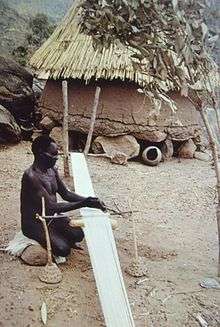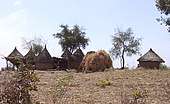Mafa people
The Mafa also called Mafahay, is an ethnic group localized in northern Cameroon, Northern Nigeria and also scattered in other countries like Mali, Chad, Sudan, Burkina Faso and Sierra Leone.
 Mafa weaver of Cameroon, 1992. | |
| Total population | |
|---|---|
| 1000000 - 2000000 | |
| Regions with significant populations | |
| northern Cameroon and Northern Nigeria. | |
| Languages | |
| Mafa | |
| Religion | |
| 15.00% Muslim, 35% African tradition followers and 50% Christian (of which 60% Catholics and 40% Protestants) |
History
It is understood that the Mafahay, a Mafa tribe, migrated from Roua and Sulede (which is west of Durum (Mofu proper)), towards the northwest. [1] The Bulahay tribe, meanwhile, migrated to the west, alongside the southern borders of the present Mafa territory. Eventually they also migrated northwards where they mixed with the Mafahay, becoming the present Mafa.[2]
Demography

Total population estimates vary between 82,100[3] and 150,000.[4] Hallaire[5] indicates that population density in the area is between 99 and 140 inhabitants per square kilometer.[1]
According to Lavergne,[6] the Mafa are split into two tribal sections, being the ‘Mafa proper’ (referred to as Maf-Mafa or ‘Mafahay), and the ‘Bulahai’. The Mafas live in the central part of the Northern Mandaras, which is a region formed by the North area of the Mokolo Plateau and the mountains of northern Mokolo. The Mafa society is divided into several cantons: Moskota; Koza; Gaboua (Koza district); (Mokolo arrondissement). There are also about 1m Mafa in Kughum (North, Nigeria).[3]
The Mafa belong to the Chadic language grouping. They speak the Mafa language,[7] with three different dialects: Mafa-west, Mafa-centre and Mafa-east. Together with many other languages of other African peoples (such as Wuzlam (Uldeme), Muyang and Ɗugwor (Dugur)), they form part of the Mafa-south sub-group.[2]
The population is 15.00% Muslim, 50% Christian and 35% tradition followers. The Christian population is composed of Catholics (60%) and Protestants (40%).[7]
Agriculture
Traditional Mafa agriculture depends on a wide assortment of soil management techniques. The hillsides are secured with constructed terraces, that according to an author, "have reached a state of exceptional perfection"[8]. Other ethno-engineering procedures include :
- small-scale irrigation
- canalization
- drainage system
Likewise, agriculturists in the mountains practice an extensive variety of soil fertility management procedures, including :
- crop rotation and mixed cropping
- agro-forestry
- biomass
- nutrient management
They also use an intensive livestock-raising system in the management of the fertility of their soil. Livestock includes smallstock and a limited amount of cattle. In the dry season between December and May, livestock is allowed to roam free, so he can consume crop residues and leaves of wild bushes.
During the farming season, livestock is put in a pen and fed. The manure that accumulates in the stables is collected, preserved and finally spread out in the fields at the end of the dry season. The intensity and ingenuity of Mafa nutrient management is illustrated by the fact that termites are used to digest harvest residues and then fed to the Chickens.[8]
References
- Bulahay Groups
- Mafa - The Mandara Mountains Homepage. Retrieved June 03, 2013, to 16: 31 pm.
- [Boulet, J., ‘Les groupes humains’, Le nord du Cameroun, des hommes, une region, Collection Memoires 102, (ed) Jean Boutrais, ORSTOM, Paris 1984:119
- Muller-Kosack, G., Cry for Death. Mandaras Publishing (www.mandaras.info). London, 1999 (4p)
- Hallaire, A., Paysans montagnards du Nord-Cameroun, Les monts Mandara, ORSTOM Editions, Collection, Paris 1991 26 Fig 5
- Lavergne, G., ‘Le pays et la population Matakam’, Bulletin de la Société d’Edudes Camerounaises 7, September 1944:7-73.
- The Joshua project. Retrieved June 03, 2013, to 16: 56 pm.
- Fred Zaal (1 April 2016). Sustainable Land Management in the Tropics: Explaining the Miracle. Routledge. pp. 145–. ISBN 978-1-317-04776-6.